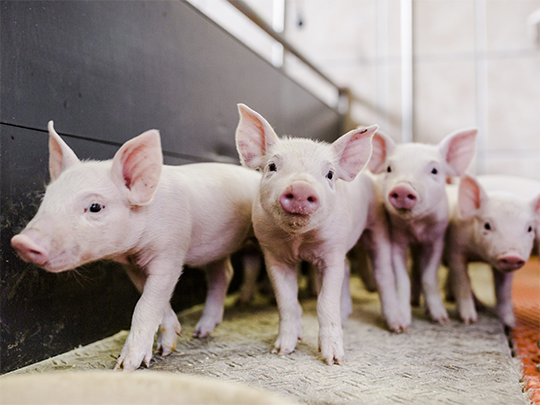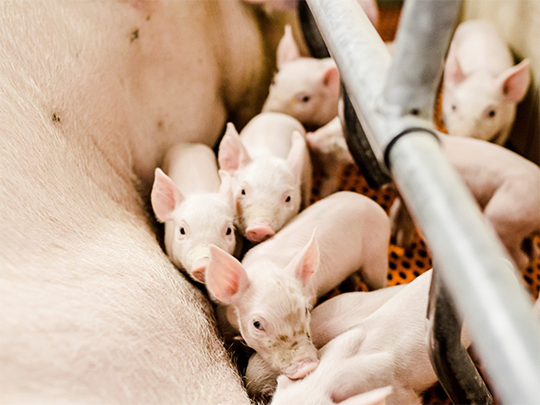Better litter performance in sows with phytogenics
Every piglet counts - low birth weight is the greatest risk factor for suckling pig losses A high litter uniformity and a high number of weaned piglets - These are the prerequisites for economic pig breeding. How can phytogenics help here?
Every piglet counts – low birth weight is the greatest risk factor for suckling pig losses
Large uniform litters and high number of weaned piglets. These are the prerequisites for economic pig breeding.
Insufficient birth weight is the greatest risk factor for suckling pig losses and is therefore of great economic importance. Especially piglets with a birth weight of less than one kilogram are at high risk.
How to improve litter performance in sows naturally?
What to read in this article?
- why nutritional management of the sow is important to optimize litter uniformity
- the positive effects of phytogenics on reproductive performance
- the effect of Fresta® F on litter performance in sows
A prerequisite for high milk production and a large number of weaned piglets is an adequate feed intake of the sows during the lactation period.
In many farms, however, the sows feed intake during lactation is reduced. As a result, the sow loses body weight. The quantity and quality of milk also decreases. One consequence is impaired piglet growth.
Did you know?
After weaning, a sow’s metabolic priority is to recover from the metabolic stresses of lactation. If the loss of body mass during the lactation period is too great, reproductive success in the following reproductive period may be impaired. Therefore, aids to increase the feed intake of the sows are welcome to support successful lactation and litter performance.

Optimized feeding for better litter performance in sows
After a period of depletion of body reserves (lactation), the sow enters a new reproductive cycle after successful insemination and pregnancy. The lactation body weight loss must be made up for in the first part of pregnancy.
This allows the sow’s body to concentrate on some relevant tasks: For example, the continuation of a normal pregnancy with good embryonic and fetal development or the development of the mammary glands.
Promoting feed intake during and after lactation, as well as good physical condition throughout the reproductive cycle, is essential for sow longevity and to achieve high litter performance – especially to increase the profitability of the farm.
Improved litter uniformity with optimized sow nutrition

In particular, low litter uniformity is due to an increased number of piglets with a birth weight below 850 g. This weight can be regarded as a critical minimum weight for survival of the piglets.
The lower the birth weight, the lower the energy reserves in form of glycogen. This leads to an increased sensitivity to cold and a reduced ability to reach the best teats. This may delay initial suckling and results in reduced colostrum intake, which affects the piglet’s survival rate and subsequent growth performance.
As weaning weight of piglets is strongly correlated with their subsequent growth performance, there is a clear need for measures to achieve high litter uniformity and to support optimized sow lactation performance and colostrum uptake by piglets.
It has been shown that feeding special ingredients and additives such as linseed oil and vitamin E has positive effects on the fatty acid and vitamin content of colostrum. In addition, unique combinations of naturally derived phytogenic additives such as vegetable essential oils, herbs and spices, mainly due to their antioxidant and anti-inflammatory properties, have a positive influence on the composition of colostrum.
Nutritional management of the sow as a key tool
The quantity of colostrum and the subsequent milk yield depend primarily on the sow’s body reserves, which are a result of nutritional management during the previous pregnancy. But more is not always good, overfeeding the sows leads to overweight, which in turn leads to a reduction in feed intake during lactation and lower milk yield.
Achieving optimal body condition and thus increased milk production of the sow, combined with increased litter size and healthy, viable piglets, seems to be one of the challenges in pig production today that needs to be addressed.

Benefits of phytogenics when it comes to litter performance in sows
The advantages of using phytogenics in the nutrition of sows and piglets are manifold. Various studies have shown that certain phytogenics not only can improve feed intake and increase nutrient uptake but also have major impact on improving the birth weight of the litters.
Manifold benefits – scientifically proven
In a field trial carried out in Costa Rica in 2017, the effect of the phytogenic feed additive Fresta® F on the reproductive performance of the sows and their offspring throughout the entire gestation and lactation period was investigated.
A total of 104 sows was used during gestation and 84 during lactation. The sows were selected based on their parity before insemination. An equal number of primiparous and multiparous sows were used across both treatments: A control group of sows fed with a basal gestation diet in gestation and in lactation (control) and the treatment group with sows fed with a basal diet supplemented with Fresta® F.
The results showed the ability of the tested phytogenic feed additive to improve litter weight at birth (Fig.1), the number of total born piglets by 8.3% and live born piglets by 9%.
Fresta® F reduced the number of dead-born piglets by 22%; increased the frequency of medium and large litters at the expense of small litters and increased the piglet birth weight for parity 1 sows by 4% and the piglet daily gain during lactation.
Sows to which the phytogenic additive was provided had lower body weight losses from farrowing to weaning, the number of culled sows was reduced by 38%, the weaning to first service interval was shortened by 6% and the successful insemination rate was increased by 2%.
Moreover, another field trial conducted in Australia, 2015, has shown an improved average daily feed intake of sows across all parities (Fig. 2).
In this trial, 176 Sows and their litter were used in the control and 178 in Fresta® F group. All sows received the same lactating basal diet; It was fed as such to the control, or with Fresta® F added on top for the treated group. The diet was fed during the entire period from 110d of gestation to weaning. Additionally, it has been shown that sows fed Fresta® F had lower average change in body score between farrowing and weaning relative to control sows and the rate of successfully remated sows was higher.
This trials have shown: By using the power of nature, we can improve litter performance I sows and lift the profit in swine farms.

Sandra Chamusco
Global Technical Manager Swine at Delacon Sandra Chamusco has a degree in Animal Science at the University of Évora in Portugal and has been working in swine nutrition for more than 20 years. She was a feed formulator and customer consultant, technical responsible and Director of Operations at the Portuguese subsidiary of the French group CCPA. After that she was Director of Swine Nutrition Department at T.N.A. (Portugal). At Delacon,Sandra is responsible for product development and product support, and for the customer technical services for the complete range of Delacon’s swine products on a global level.











very good blog, many information with good picture, make customer confidence with product of Delacon, very appreciate with Marketing team and technical team. congratulation